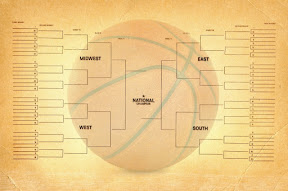“March Madness,” the annual NCAA Division 1 postseason basketball tournament, starts Thursday. For a population of sports-hungry Americans, the tournament is one of the marquee events of the year. For corporate managers hell bent on maintaining the utmost level of employee engagement and productivity during the workday, it is a nightmare.
Or is it?
The hoopla started Monday — the day after the NCAA selection committee determined the 68-team field — as workers perused spreadsheets and ran complicated probability queries — only, it wasn’t work-related. Many were filling out their tournament bracket, teaming with co-workers to determine each round’s winners and entering into office pools or competitions.
What’s more, about half of the tournament’s 32 or so first-round games that will be played Thursday and Friday will take place during work hours. That means a hefty percentage of the workforce will be streaming the games live, obsessively checking scores and updates, or searching for a television, hoping not to miss a last-second, buzzer-beater basket that leads to a major upset.
With the mass hysteria of the tournament’s on-the-court theatrics comes a common concern among talent managers that the event serves as a major distraction: Workers are spending more time following the games during those work days than they are working. Meanwhile, social media — namely Twitter — has made not working and following the games a whole lot easier.
The dread of lost employee engagement — and, in turn, lower productivity — during the tournament span is usually supported by a mild wave of statistics seeking to show a dramatic loss of dollars to the U.S. economy, usually in the form of wages paid to workers for time when they weren’t working.
Outplacement firm Challenger, Gray & Christmas Inc. has this year’s tournament taking up an average of 90 minutes of workers’ time per day. If private-sector workers earn an average of $23.29 per hour, the study estimates, U.S. employers may end up paying workers about $175 million this year for time they are following the games, according to Challenger.
“Statisticians, economists, academia and college basketball fans will likely scoff at that estimate — and rightfully so,” said John A. Challenger, the firm’s CEO, in a release. “It is to be taken with a grain of salt, as it is meant to be a tongue-in-cheek look at how technology continues to blur the line between our professional and personal lives.”
CNBC sports business reporter Darren Rovell went as far as calling last year’s Challenger wages-lost estimate — $192 million — “the most bogus estimate of the year.” In a column leading up to last year’s tournament, Rovell — who openly roots for the Northwestern University Wildcats, his alma mater, on Twitter — wrote that the Challenger report hinges on a “horrible” assumption: Workers are productive during every minute of every workday.
This, of course, is not true. Even during times without a basketball tournament to absorb their attention, employees are rarely engaged in work 100 percent of the time.
But even if employees are not completely engaged in work at all times, perhaps some of the distraction served by the tournament actually helps workers be more productive with the time they are using for work.
In April 2011, James Surowiecki of The New Yorker penned an article suggesting that forcing employees to refrain from bits of Internet-related distractions during work — as many companies do — might actually make them less productive, not more. Surowiecki cites a study from the University of Copenhagen, which asked participants to watch a video of people passing balls and then to count the number of balls. Some had a funny video interrupt them on their screens; others simply saw a message telling them a funny video would be available for them if they clicked on a button, but that they could not watch it.
“After 10 minutes, during which people in the second group could hear those in the first laughing at the video, everyone set to the task of counting the number of passes. And the curious result was that those who hadn’t watched the comedy video made significantly more mistakes than those who had,” Surowiecki wrote.
In this case, “it was the act of following company policy and not clicking that button that eroded people’s ability to focus and concentrate.”
Perhaps workers distracted by March Madness are actually more productive because of the energy and excitement the tournament gives some workers — it makes a normal workday extraordinary. The University of Copenhagen study certainly lends well to that argument.
In any event, it appears that the staid policy of restricting workers from paying attention to the tournament during the work day is fading.
Major League Baseball’s Arizona Diamondbacks organization actually turns March Madness into an annual employee engagement and team building activity. The club has its front office workers get into teams of 10 people from various departments, a special lunch is organized, and each team is asked to come up with a team name and to fill out their tournament bracket together.
“We put all of those [brackets] on an online tool, where people can watch the standings when the games are played and can trash talk back and forth,” said Marian Rhodes, the club’s senior vice president and chief human resources and diversity officer.
At the end of tournament, after the national championship game is played, first-, second- and third-place teams are awarded prizes. “It’s a lot of fun for our employees,” Rhodes said.
Indianapolis-based pharmaceutical giant Eli Lilly & Co. places special events, such as March Madness, under its year-round policy on flexible working arrangements for employees.
“Flexibility,” as the company terms it, is a productivity tool that “allows for adaptation of how, when and where work is completed.” Supervisors openly discuss with their employees their needs and how various types of flexible arrangements are structured, according to a company spokeswoman, Janice Chavers.
“For some positions, such as manufacturing operational roles,” Chavers wrote in an email, “employees need to be present during a certain set of hours. But, for others, flexible work arrangements are possible.”
Such a policy at Eli Lilly — whose local favorite, the Butler University Bulldogs, were national runners-up in the last two tournaments — certainly isn’t limited to events like March Madness.
Many of the firm’s employees took advantage of its flex working policy when this year’s Super Bowl was hosted in Indianapolis — and various related events and activities took to the city’s streets. While some employees might ask for flexibility in their work schedule to attend a March Madness game — many of the regional matchups have been played in Indianapolis — others might want to attend a popular play or other event in town.
“We certainly have lots of sports excitement around here,” Chavers said. “And yes, our employees have opportunities to take advantage of the activities [of March Madness],” as long as it doesn’t interrupt of the progress of their work.
“As far as tracking a game while you are in the office,” she added, “again, that would depend on the particular job and the amount of time one can take for breaks. Yes, many of us certainly tracked Butler’s progress!”
In his firm’s release, Challenger suggests that employers not squander employee interest in March Madness, but embrace it as a means of team building and boosting morale. He goes as far as to suggest that employers put televisions in break rooms and organize companywide bracket pools — akin to the Diamondbacks.
Unless the tournament proves to be a significant problem — employees fail to meet deadlines or customer service is heavily diminished as a result — talent managers should just turn their heads the other way.
“If employees are getting all of their work done and customers are happy and the biggest problem is a slow Internet connection for a couple of days,” he said, “it may be best to let it slide.”
Frank Kalman is an associate editor of Talent Management magazine. He can be reached at fkalman@talentmgt.com.















